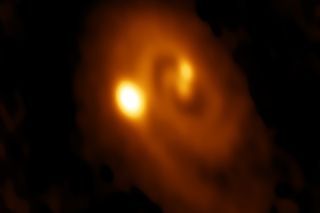
Nemesis is apparently real, even if its bad reputation is undeserved.
For decades, some scientists have speculated that the sun has a companion whose gravitational tug periodically jostles comets out of their normal orbits, sending them careening toward Earth. The resulting impacts have caused mass extinctions, the thinking goes, which explains the putative star's nickname: Nemesis.
Now, a new study reports that almost all sun-like stars are likely born with companions, bolstering the case for the existence of Nemesis. [Solar Quiz: How Well Do You Know the Sun?]
"We are saying, yes, there probably was a Nemesis, a long time ago," study co-author Steven Stahler, a research astronomer at the University of California, Berkeley, said in a statement.
But the new results don't paint Nemesis as a murderer: The sibling star probably broke free of the sun and melted into the Milky Way galaxy's stellar population billions of years ago, study team members said.

Multistar systems such as Alpha Centauri — the sun's nearest neighbor, which harbors three stars — are common throughout the Milky Way. Indeed, recent computer-simulation research suggests that most if not all stars are born with companions.
The new study put this supposition to the observational test. Stahler and lead author Sarah Sadavoy, of the Smithsonian Astrophysical Observatory, studied the Perseus molecular cloud, a large star-forming region about 600 light-years from Earth.
Get the Space.com Newsletter
Breaking space news, the latest updates on rocket launches, skywatching events and more!
Radio observations of the Perseus cloud by the Very Large Array in New Mexico and the James Clerk Maxwell Telescope in Hawaii revealed 55 young stars in 24 multistar systems (most of which were binary), as well as 45 single-star systems..
"The key here is that no one looked before in a systematic way at the relation of real young stars to the clouds that spawn them," Stahler said.
Sadavoy and Stahler found that all of the observed "wide binary" systems — the ones with stars separated by at least 500 astronomical units (AU) — were very young. Older binary systems were more compact, the researchers said. (One AU is the average Earth-sun distance: about 93 million miles, or 150 million kilometers).

The two researchers then did some modeling work to better understand what they were seeing.
"We ran a series of statistical models to see if we could account for the relative populations of young single stars and binaries of all separations in the Perseus molecular cloud," Stahler said. "And the only model that could reproduce the data was one in which all stars form initially as wide binaries. These systems then either shrink or break apart within a million years."
In fact, the majority of newborn binary stars — about 60 percent — end up going their separate ways, the duo determined. This was probably the fate of Nemesis and the sun, the new study suggests.
The paper has been accepted for publication in the journal Monthly Notices of the Royal Astronomical Society. You can read it on the online preprint site arXiv.org.
Follow Mike Wall on Twitter @michaeldwall and Google+. Follow us @Spacedotcom, Facebook or Google+. Originally published on Space.com.
Join our Space Forums to keep talking space on the latest missions, night sky and more! And if you have a news tip, correction or comment, let us know at: community@space.com.

Michael Wall is a Senior Space Writer with Space.com and joined the team in 2010. He primarily covers exoplanets, spaceflight and military space, but has been known to dabble in the space art beat. His book about the search for alien life, "Out There," was published on Nov. 13, 2018. Before becoming a science writer, Michael worked as a herpetologist and wildlife biologist. He has a Ph.D. in evolutionary biology from the University of Sydney, Australia, a bachelor's degree from the University of Arizona, and a graduate certificate in science writing from the University of California, Santa Cruz. To find out what his latest project is, you can follow Michael on Twitter.
Most Popular

